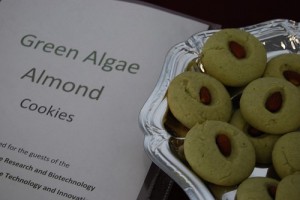August 6, 2013
 Although algae has been highlighted for its potential as an alternative fuel source, this special microorganism has also established itself in an array of other marketable fields. Feeds, cosmetics, and plastics are only a few areas in which algae can be utilized to create a product. This blog post will dive deeper into areas of algae research that strengthen and secure the future of important markets other than energy.
Although algae has been highlighted for its potential as an alternative fuel source, this special microorganism has also established itself in an array of other marketable fields. Feeds, cosmetics, and plastics are only a few areas in which algae can be utilized to create a product. This blog post will dive deeper into areas of algae research that strengthen and secure the future of important markets other than energy.
Plastics:
We use a lot of plastic. The Clean Air Council reports that Americans throw away enough paper and plastic cups, forks, and spoons to circle the equator 300 times. Items that are used often such as disposable packaging containers at restaurants, agricultural and horticultural plastic films, and plastic encasings for makeup, technology, and the like are in need of a sustainable alternative to decrease our carbon footprint. Biodegradable plastics fulfill a need for our plastic consumption because they decompose into natural elements in a reasonable amount of time. The company Algix has been developing a new breed of organic algae plastics to be used in industrial, commercial and retail applications. Algae plastics are still in the early beginnings and have been questioned because of its lack of durability, butsome researchers believe that genetic engineering of certain algae strains will provide the same quality of traditional plastics in time.
Therapeutics:
Algae is made up of nutrient rich compounds that have been proven to prevent disease and sustain health and vitality. In April, Algae Industry Magazine published a six-part article series titled “Algae Medical Solutions” in which they highlighted algae as a great resource for health improvement. People who struggle with digestive problems, obesity, or nutrient deficiency can turn to algae to help boost and restore healthy functioning of important organs and body systems by taking algae health supplements. In May, Health Enhancement Products Inc. (HEPI) announced their partnership with ASU’s Algae Technology and Innovation (AzCATI) and the Algae Testbed Public-Private Partnership (ATP3). Their partnership plans to provide HEPI with a broader range of scientific expertise by opening access to algae experts and facilities. The company plans to develop natural products derived from algae cultures for use as dietary supplements and food ingredients. Researchers at the University of Arizona also announced plans of contributing toward algae therapeutics by repurposing a Tucson wastewater treatment plant into a fish hatchery and algae omega-3 research facility. Omega-3 is considered to be an essential fatty acid that is rich with health benefits. Omega-3 can be found in both fish and algae. The omega-3 found in fish is actually produced due to the tendency of fish to feed on algae. Algal omega-3 is mercury-free and can be sustainably produced from waste nutrients using energy from sunlight to lower cost. This research could be beneficial to pursuing new research in algae-based therapeutics and foods.
Cosmetics:
Slimy green algae might not be the first thing you think of when it comes to beauty products, but believe it or not, algae have true potential in this market. Algae can act as a thickening or water-binding agent that is important to the manufacturing of oil-based cosmetics. Algae also contain many important vitamins and proteins that can be beneficial to the skin. The company Oilgae has presented some interesting facts on the potential for algae for cosmetics. Algae cosmetics that have been researched and developed include algal soaps, algal clay mask, algae beauty serum, algal beauty oil, algal oil/salt scrub, and algal whole cell shampoo and conditioner. ASU spinout company Heliae has also introduced algae into their health and beauty research. Heliae collaborates with leaders in the natural cosmetic fields to produce sustainable ingredients made from algae for their health and beauty product lines. One company that Heliae collaborates with is Spa Technologies which utilizes a variety of different algae strains to create skin care and health care products. Dan Fryda, the founder and president of Spa Technologies, has also written a book on the therapeutic uses of marine algae and seawater and it is due to be released online this Fall.
Air and Water Purification:
Acting as a renewable fuel is not the only way algae benefits our environment. It has also been proven to reduce levels of carbon dioxide in our atmosphere as well as cleaning up wastewater. The Department of Energy reported that microalgal cultures are able to capture up to 45% of available CO2 from a wide variety of simulated flue gases and from actual coal and propane combustion gases. In 2011, ASU partnered with Intel Corporation to research a carbon capture project using algae grown from their factory boiler stack CO2 emissions. Below is a video that provides an informal summary of the project.
ASU has also researched and developed the ability for algae to treat wastewater. It started in 2010 when ASU graduate students Josh Wray, Martha Kent, and Emil Puruhito earned an Edson Student Entrepreneur Initiative grant. Their innovative plan aimed on providing a business strategy to produce a sustainable organic fertilizer from algae. This initial project then transformed into a proposal for the National Water Research Institute toward developing a new bioreactor design for use in wastewater treatment. The team was awarded $5,000 for two years of research and development of their project. In 2011, the team was additionally awarded the P3 Award from the EPA for their project "Developing Commercially Viable Culture Media from Wastewaters Optimized for the Emerging Microalgae-based Biofuel Industry". The project period took place between August 15, 2011 and August 14, 2012 with a funding amount of $15,000.
Feeds:
 Algae have been a part of a healthy diet for humans and animals for centuries. Researchers at Cornell University are considering algae-based animal feed as a replacement for traditional corn and soybean feed. Algae are rich in protein and have 50 times more oil an acre. Thismeans that manufacturers can use less land and water to produce algae-based animal feed which reduces their carbon footprint and benefits the environment. Algae can also be a sustainable food choice for humans. ASU Professor Mark Edwards has claimed that algae could make a large impact in combating world hunger. As stated earlier, algae have many nutrient and protein-rich properties that can be used as supplements in food. Therefore, Dr. Edwards does not believe that people will just eat algae, but most likely use it as a replacement for fish, fodder, and food ingredients. Developing algae supplements also uses significantly less water and little-to-no fuels or chemical fertilizers in production, which makes it an environmentally responsible choice for our future. Algae can be served for dessert as well! Check out these algae cookies showcased at the AzCATI grand opening.
Algae have been a part of a healthy diet for humans and animals for centuries. Researchers at Cornell University are considering algae-based animal feed as a replacement for traditional corn and soybean feed. Algae are rich in protein and have 50 times more oil an acre. Thismeans that manufacturers can use less land and water to produce algae-based animal feed which reduces their carbon footprint and benefits the environment. Algae can also be a sustainable food choice for humans. ASU Professor Mark Edwards has claimed that algae could make a large impact in combating world hunger. As stated earlier, algae have many nutrient and protein-rich properties that can be used as supplements in food. Therefore, Dr. Edwards does not believe that people will just eat algae, but most likely use it as a replacement for fish, fodder, and food ingredients. Developing algae supplements also uses significantly less water and little-to-no fuels or chemical fertilizers in production, which makes it an environmentally responsible choice for our future. Algae can be served for dessert as well! Check out these algae cookies showcased at the AzCATI grand opening.
Who would have known that pond scum would have the potential to fulfill so many needed markets and solutions? If it were not for research and development of algae technology then all of these innovative ideas would not be known. AzCATI and ATP3 continue to take the forefront of expanding our knowledge of what algae can do. We commend Arizona State University for supporting these brilliant researchers and providing state-of-the-art facilities to explore the multiple facets of utilizing algae for the future.
Written by Gabrielle Olson, ASU LightWorks
Illustration of the various uses for algae by Nils-Petter Ekwall. Photo retrieved from Sweden.Se and Sydney Lines, ASU LightWorks
Additional Information:

